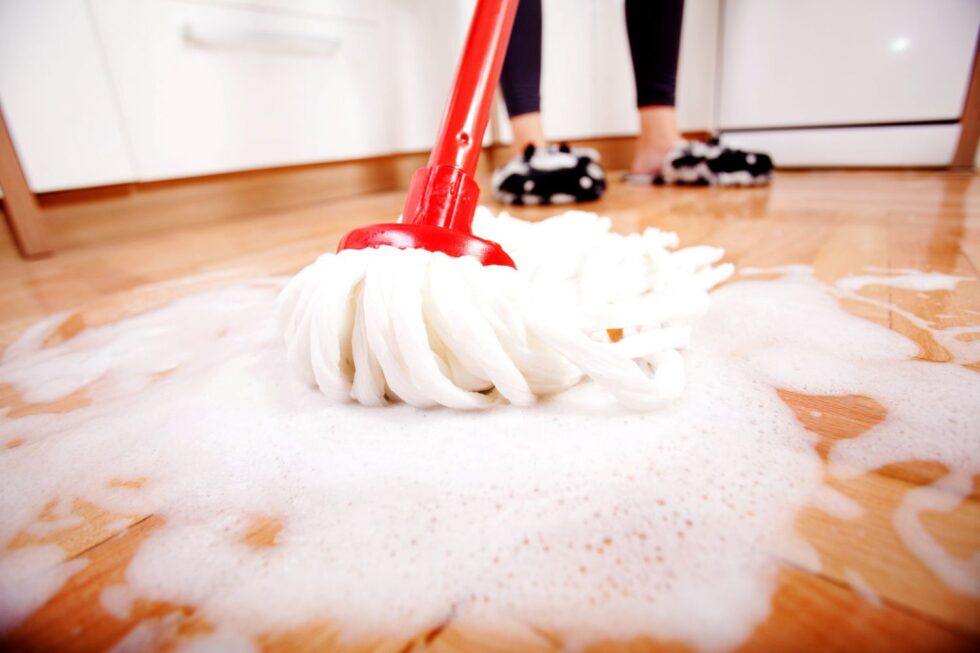Why hot water can ruin your floor — cleaning experts warn against a common household mistake

At first glance, it seems logical to mop with hot water: it dissolves grease, breaks down dirt faster, and enhances the effect of detergents. In kitchens and bathrooms, this logic works — but when it comes to floors, experts say it’s one of the most common household mistakes. Hot water not only fails to clean more effectively but can actively damage the material, leaving dull marks, warped surfaces, and even hidden structural problems over time, reports G.business.
The invisible danger: what really happens when you use hot water
When hot water touches a modern floor — especially laminate, vinyl, or engineered wood — it starts a reaction beneath the surface. The sudden temperature difference causes microscopic cracks or softens the adhesive layer holding the material together. Over time, this leads to swelling, warping, or peeling of the decorative surface.
Even porcelain or ceramic tiles aren’t immune. Hot water accelerates evaporation, leaving cleaning agents to dry before they can be rinsed away. These residues form a cloudy film, dulling the finish and collecting dust faster. Many homeowners misinterpret this as “dirt returning,” when in fact it’s chemical buildup caused by improper cleaning.
Expert insight: how temperature affects cleaning chemistry
According to cleaning specialists, detergents are designed to work optimally within a moderate temperature range — around 25 to 35 °C. Above this threshold, the active ingredients degrade faster, reducing their ability to break down grease.
Moreover, hot water evaporates almost instantly, preventing detergents from being properly diluted or rinsed away. This “sticky film effect” traps small particles, so instead of removing dirt, you end up sealing it into the surface.
“People often think heat equals hygiene, but cleaning isn’t sterilization,” explains hygiene expert Dr. Lara Münch. “For most household floors, temperature stability matters more than boiling power.”
The right way to mop — tested, simple, and streak-free
1. Choose the right temperature
Use cool to lukewarm water (ideally between 25–35 °C). This allows cleaning agents to activate without rapid evaporation.
2. Mix detergents correctly
Always follow the recommended dosage on the label. Too much cleaner makes the floor sticky; too little doesn’t dissolve dirt. The right balance ensures even shine.
3. Two-step cleaning method
For heavily soiled floors, professionals suggest a two-phase system:
- Step 1: Wipe with hot water only (no chemicals) to loosen grease.
- Step 2: Mop again with lukewarm water and mild cleaner to remove residues.
This technique deep-cleans without damaging the surface.
4. Dry finishing
After wet mopping, use a dry microfiber mop or cloth to absorb remaining moisture. This step prevents streaks, restores gloss, and protects wooden or laminate joints from swelling.
5. Routine over intensity
Regular maintenance beats extreme heat. Cleaning once a week with cool water is far safer than using hot water monthly.
When is hot water actually useful
There are a few exceptions. Steam cleaners use pressurized vapor, not liquid heat. The micro-steam penetrates dirt and disinfects without soaking the surface. It’s particularly effective for tile and stone floors — but only when used according to manufacturer instructions.
For non-decorative surfaces such as garage concrete, basement floors, or outdoor terraces, hot water can help remove oil stains or mold. However, it should never be used on finished interior flooring or areas with sensitive coatings.
The psychological trap: why hot feels “cleaner”
Humans associate warmth with cleanliness and comfort — from hot showers to steamy dishwashing. This mental shortcut often makes us believe that higher temperature means deeper cleaning. Yet, experts say this is a myth.
Hot water doesn’t necessarily kill germs unless combined with disinfectant and sustained high heat — something domestic mopping can’t achieve. Instead, it risks material fatigue and chemical residue, giving a false impression of “freshly cleaned” when the surface is, in fact, deteriorating.
Pro-approved cleaning hacks for radiant floors
- Add one tablespoon of white vinegar or lemon juice to 5 liters of lukewarm water — a natural, streak-free cleaner.
- Always use two buckets: one for detergent water, one for rinsing. This prevents re-spreading dirt.
- Rinse your mop frequently in clean water to avoid streaks.
- Polish afterward with a dry microfiber cloth to restore natural shine.
- Ventilate rooms immediately after cleaning to prevent moisture buildup and odor.
- For wooden floors, add a few drops of essential oil (like eucalyptus or lavender) for a pleasant scent and mild antibacterial effect.
- Spot-clean stains promptly instead of mopping the entire floor — it saves time and water.
Hot water creates an illusion of fast cleaning, but true hygiene comes from balance, patience, and the right method. Whether you live with laminate, parquet, vinyl, or tile, your floors last longer when treated gently. Cooler water, proper rinsing, and regular care guarantee not only cleanliness but also a lasting shine — the kind that feels fresh, not forced.
Stay connected for news that works — timely, factual, and free from opinion — and insights that matter now: What are the 10 proven tips to remove bad smells at hom